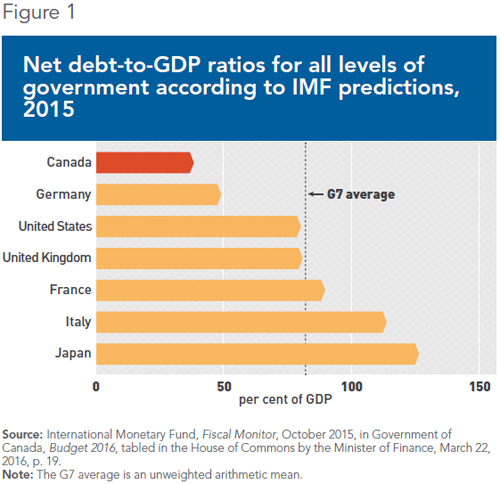Viewpoint – Does Canada Really Have the Leeway to Take on More Debt?

In the introduction to its budget plan tabled earlier this week, Canadian Finance Minister Bill Morneau announced a deficit of $29.4 billion for the 2016-2017 year, or $1,631 per net taxpayer, and total deficits of $113 billion over the next five years. One of the arguments raised in the document in favour of this substantial new debt is that Canada’s current overall debt is much lower than that of the other G7 countries, which gives the federal government the leeway to take on more debt. However, this comparison is based on the net debt, which distorts the situation. The use of another measure, gross debt, paints a very different picture.
Media release: Canada’s leeway to take on more debt is an accounting fiction
 Links of interest
Links of interest
 |
 |
 |
|
Interview (in French) with Mathieu Bédard (Mario Dumont, LCN, March 24, 2016)
Debate (in French) with Mathieu Bédard (À la une, ARGENT business news network, March 24, 2016) |
Viewpoint – Does Canada Really Have the Leeway to Take on More Debt?
In the introduction to its budget plan tabled earlier this week, Canadian Finance Minister Bill Morneau announced a deficit of $29.4 billion for the 2016-2017 year, or $1,631 per net taxpayer, and total deficits of $113 billion over the next five years.(1)
One of the arguments raised in the document in favour of this substantial new debt is that Canada’s current overall debt is much lower than that of the other G7 countries, which gives the federal government the leeway to take on more debt. However, this comparison is based on the net debt (see Figure 1, which reproduces the graph from the budget document), which distorts the situation. The use of another measure, gross debt, paints a very different picture.

Why It Is the Gross Debt That Must Be Used
The use of net debt does not reflect governments’ budgetary reality. Net debt is a measure that subtracts financial assets from the gross debt.(2) In the case of Canada, the net debt is the debt minus, for example, public service pension plan assets, or liquid assets held by the government in the form of deposits, dollars, and any other tradeable financial assets.
The hypothesis that supports the use of net debt rather than gross debt is that if the government should one day be faced with a debt crisis, which is not looming for Canada, it could sell these assets in order to reimburse its debt. This perspective, defended by the preceding government in its 2015 budget,(3) rests on the fact that the measure of the gross debt puts Canada at a disadvantage in international comparisons. This is due to the fact that Canada has a lot more financial assets than most other countries to provide for the retirement of its public employees, which implies a bigger amount subtracted from its gross debt.
The problem with using this measure comes from the fact that it is basically an accounting fiction. The government, even in a time of crisis, could not rid itself of its financial assets to reimburse its debt since it always needs liquidity for its normal operations and it always needs to provide for the future retirement of its public employees. It is difficult to imagine a government willingly rendering itself unable to ensure its proper functioning because of a lack of liquidity or selling its public service retirement assets in order to reimburse its creditors.
Furthermore, the government does not pay interest on the net public debt, but on the gross debt. According to the most recent budget, gross public debt charges amount to $25.7 billion today, and will rise to $35.5 billion in 2020-2021.(4) It is these payments that make it difficult to lower taxes and that limit the amount of room the government has to manoeuvre, which has nothing to do with the net debt.(5)
When Canada’s gross public debt is compared with that of other countries, the picture that emerges is very different. By using gross debt instead of net debt, Canada’s debt-to-GDP ratio goes from 38% to 90%. As can be seen in Figure 2, Canada is therefore very close to the average of the other G7 countries. The substantial leeway the federal government claims to have when it compares Canada with other countries therefore does not exist, and cannot justify the large future deficits announced in the budget.

This Viewpoint was prepared by Mathieu Bédard, Economist at the MEI. He holds a PhD in economics from Aix-Marseille University, and a master’s degree in economic analysis of institutions from Paul Cézanne University, and by Youri Chassin, Economist and Research Director at the Montreal Economic Institute, who holds a master’s degree in economics (Université de Montréal). The MEI’s Taxation Series aims to shine a light on the fiscal policies of governments and to study their effect on economic growth and the standard of living of citizens.
References
1. Government of Canada, Budget 2016, tabled in the House of Commons by the Minister of Finance, March 22, 2016, p. 234.
2. International Monetary Fund, World Economic Outlook: Uneven Growth: Short- and Long-Term Factors, April 2015, p. 165.
3. Government of Canada, 2015 Budget, Annex 2 – International Debt Comparisons, March 21, 2015.
4. Government of Canada, op. cit., footnote 1, p. 242.
5. For a similar argument regarding Quebec’s net debt and gross debt, see Francis Vailles, “Bonnes et mauvaises nouvelles sur la dette,” La Presse, May 29, 2015.
———————————–
Clarification (April 2016): To illustrate the financial assets that are deducted by the IMF from the gross debt to obtain its net debt measure used in the Government’s 2016 budget, this Viewpoint erroneously gave the example of civil servants' pensions. This is a bad example because the IMF does not deduct the pensions of civil servants in this measure of the net debt of G7 countries. Other examples provided by the Viewpoint, such as the necessary liquidity for the normal operations of the government, are a better illustration. In its response, the Department of Finance Canada further specifies that the IMF also deducts “currency and deposits, loans, short-term paper, bonds and debentures, foreign investments, equity and investment fund shares, government claims and other receivables.”

